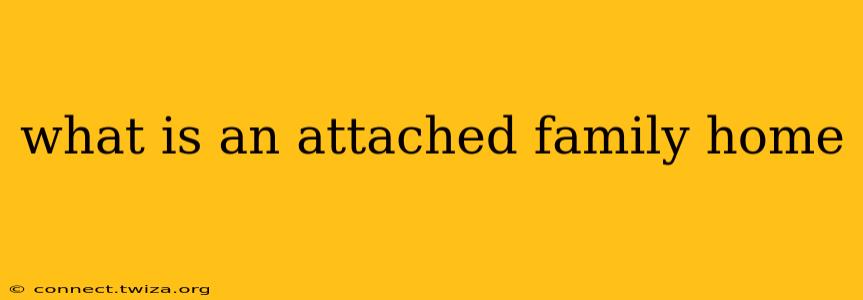An attached family home refers to a residential dwelling that shares one or more walls with another dwelling. This contrasts with a detached home, which stands alone on its own lot. Understanding the nuances of attached homes is crucial when considering your housing options, as they offer unique advantages and disadvantages. This comprehensive guide will explore the various types of attached homes and help you determine if this style of living is right for you.
What are the Different Types of Attached Homes?
Several types of attached homes exist, each with its own characteristics:
-
Townhouses: These are multi-story homes, typically two or three stories high, sharing at least one common wall with adjacent units. They often feature a small yard or patio and are usually part of a larger development.
-
Row Houses (Rowhomes): Similar to townhouses, row houses are attached homes arranged in a continuous row. They typically share walls with the units on either side. They often have less exterior space than townhouses.
-
Condominiums (Condos): While condos can be attached or detached, attached condos are frequently found in multi-unit buildings. Ownership is individual, but shared amenities and common areas are managed by a homeowner's association (HOA).
-
Duplexes: These buildings consist of two separate housing units, typically sharing a common wall. Each unit is usually owned or rented separately.
-
Multi-family Dwellings: This is a broader category encompassing several units within one building, including triplexes, quadruplexes, and larger apartment buildings. While the focus here is family homes, it's important to note that many multi-family dwellings can be suitable family residences.
What are the Advantages of Living in an Attached Family Home?
Choosing an attached home offers several key benefits:
-
Affordability: Attached homes are often less expensive than detached homes, especially in desirable areas. Shared walls reduce construction costs, making them more accessible to buyers.
-
Maintenance: HOAs often handle exterior maintenance (roof, landscaping, etc.), freeing up homeowners' time and reducing their responsibilities.
-
Community: Living in close proximity to neighbors can foster a stronger sense of community and shared social interaction.
-
Location: Attached homes are often found in convenient locations, closer to urban centers and amenities.
-
Energy Efficiency: Shared walls can contribute to better insulation and potentially lower energy bills.
What are the Disadvantages of Living in an Attached Family Home?
It's essential to consider the drawbacks as well:
-
Less Privacy: Shared walls mean less privacy than in a detached home. You may hear your neighbors more easily.
-
HOA Fees: Many attached homes are governed by HOAs, which levy monthly fees for common area maintenance. These fees can be substantial.
-
Limited Outdoor Space: Attached homes typically have less outdoor space than detached homes.
-
Less Customization: HOAs often have rules and regulations that restrict exterior modifications and landscaping choices.
-
Noise: Noise from neighbors can be a significant issue, especially in densely populated attached housing developments.
What is the Difference Between an Attached Home and a Detached Home?
The primary difference lies in the level of physical connection to other homes. Detached homes stand alone on their own lots, offering complete privacy and independence. Attached homes, as discussed, share one or more walls with adjacent units. This fundamental distinction influences privacy, cost, maintenance, and overall lifestyle.
How Much Does an Attached Family Home Cost?
The cost of an attached family home varies significantly depending on location, size, age, and amenities. Factors like the presence of an HOA and the quality of the construction also impact price. To get a realistic estimate, you need to research the specific market where you are looking to buy.
What are the Best Types of Attached Family Homes?
The "best" type depends entirely on individual preferences and needs. Families with young children might prefer a townhouse with a small yard. Those prioritizing affordability might opt for a duplex or a condo. Ultimately, the ideal choice depends on a careful evaluation of your priorities and lifestyle.
This guide provides a comprehensive overview of attached family homes. Remember to carefully research different options and consider your personal needs and preferences before making a decision. Consulting with a real estate professional can also be beneficial.
